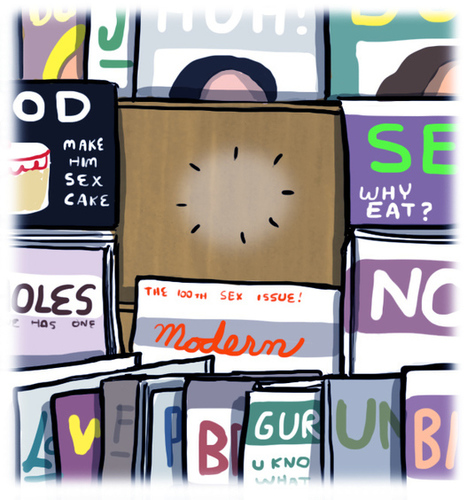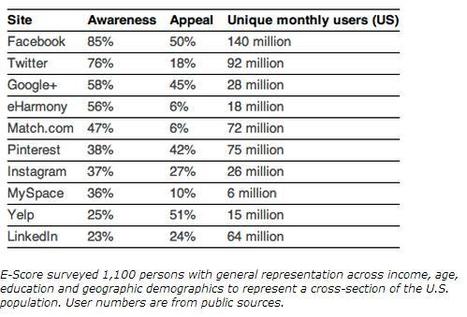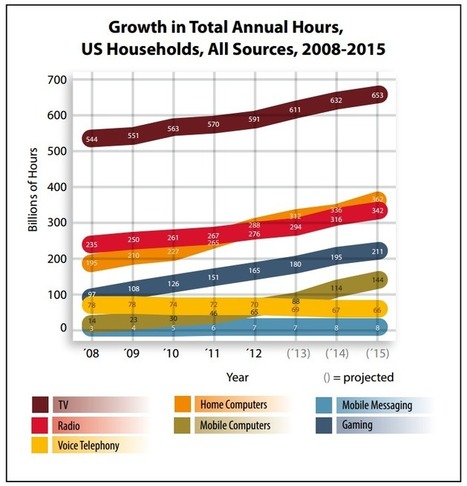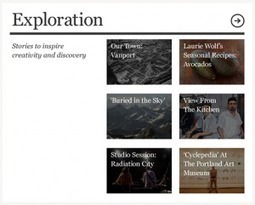 Your new post is loading...
 Your new post is loading...
How news organisations are building commercial teams of former journalists who create paid-for content on behalf of brands...
The Huffington Post, in conjunction with parent company AOL, last month published a report which proposed that native advertising is "sponsored content, which is relevant to the consumer experience, which is not interruptive, and which looks and feels similar to its editorial environment".
Perhaps the easiest way to understand it is by looking at a couple of examples, such as the Guardian's 'what to wear on a date' video, sponsored by John Lewis, with clothes featured in the video from the department store, and BuzzFeed's '20 coolest hybrid animals', created for hybrid car Toyota Prius....
Steve Hind: When readers are lured in and rewarded for their curiosity with good content, everyone wins. Sites like Buzzfeed use this to their advantage, and traditional media should take note..
.Last week the internet was treated to another great offering from Randall Munroe, author of the xkcd cartoon blog.
In it, Munroe re-imagined 20th century headlines if they were written to get more clicks. "This one weird mould kills all germs" could have applied to the discovery of penicillin in 1928. "You won't believe what these people did to the Berlin Wall" could have appeared in November 1989 for maximum effect.
His point, of course, was that the "clickbait-ification" of our news is cheapening it....
Today it was revealed that Vox Media, owner of The Verge, SB Nation, and Polygon has raised another $40 million of funding.
...But bigger exits are emerging: There was Huffington Post and Bleacher Report. There’s that Vice valuation. And even Swisher and Mossberg without a site are rumored to be in the $30 million valuation size — bigger than what TechCrunch sold for after six years. A pattern is forming.
The investments in Buzzfeed and Vox in particular show that well-heeled investors believe that new media can be more than just profitable lifestyle businesses buoyed by non-scalable event franchises. These guys are betting there are big public companies here.We’re seeing the same kind of transition with content that we saw with the early Web 2.0 companies like Delicious and Flickr. They sold out cheap at first as projects morphed into companies and then the next generation thought bigger....
In a recent speech, Guardian deputy editor Katharine Viner described how she believes the social web and the practice of “open journalism” fundamentally changes the relationship that journalists have with their audience...
But the real meat in Viner’s speech is her argument about how all of this changes (or at least should change) the nature of a journalist’s relationship with what Jay Rosen and Dan Gillmor have called “the people formerly known as the audience.”
“Digital is not about putting up your story on the web. It’s about a fundamental redrawing of journalists’ relationship with our audience, how we think about our readers, our perception of our role in society, our status. We are no longer the all-seeing all-knowing journalists, delivering words from on high for readers to take in, passively.”...
Hal Varian, Google’s chief economist, talked about the challenges facing the newspaper business in a recent presentation in Italy, and showed that he understands those challenges better than most media executives.
Gannett has a new social media policy for journalists, and though it is similar to those established by many other news outlets, it does serve as a reminder that it’s getting harder than ever for journalists to draw the line between their public and private lives.
Here are some of the policy specifics that target journalists (emphasis added)....
From time to time, media reports on the latest tectonic shift in digital devices and the associated increase in time we spend online are a prophesy - the death of all TV viewing is imminent. Statements like this one recently, "the steady increase in online traffic is cannibalizing TV viewing and effectiveness," have been uttered by pundits periodically over the past decade or more, driving hysteria throughout the industry with marketers left to wonder if it is truly and finally the end of TV advertising as we know it. Isn't it inevitable?
Turns out the answer is 'yes' and 'no'. TV viewing behavior has been permanently altered, and the change (while glacial vs. 'shock and awe') has been sweeping. That said, the net real effect on TV's pivotal role as THE video medium has been minimal – indeed, online viewing has been growing in tandem with not at the expense of overall TV viewing. BOTH online and TV platforms are witnessing record engagement numbers, with television still very much at the helm. Indeed, traditional, living room, TV consumption has grown year-over-year in the U.S., and continues to dominate as consumers seek out appealing entertainment and information[1]. W
ith growing consumer appetite for content and increasing dexterity with mobile devices, adoption of smartphones and tablets will continue to rise, but ALL indications are that television will remain the glowing centerpiece in the living room for the foreseeable future....
The New York Times Company did the world of journalism a big favor today.The company finally disclosed the exact revenues of its digital business.The numbers were impressive. And they made clear that no one ever needs to fret about the future of journalism again.Specifically, the New York Times reported that the revenue of its digital business is now about $360 million a year....
Innovative storytelling, audience engagement, and financial flexibility are key ingredients for newspapers to cope with pressures from competitors, budget constraints, and the speed at which technology is changing."It came as no surprise when The New York Times took home a Pulitzer for 'Snow Fall' - the immersive multimedia package impressed journalists and web designers alike with its seamless integration of text, audio, videos, photos and interactive graphics."The comments in "Trends in Newsrooms 2013," the World Editors Forum's report on the state of the news industry, about the attention-grabbing content, underlined the importance of stories that jump out at readers....
Does this signal the beginning of the end for Forbes as a knowledgeable source of business information? Have they finally "jumped the shark" on their way to the exit? "Jumping the shark" is actually an expression that goes back to the TV sitcom series, Happy Days. It was a show that pictured everything as rosy and happy, with neat little endings that were all nicely tied up in twenty-two minutes. The chief influencers on that show were "The Fonz," who only had to give you a look to let you know you were in trouble, and Mr. Cunningham, who set down the rules of the family.
In the midst of its ten-year run the writers must have gotten tired or were negatively influenced by the Hollywood decision-makers, when they inexplicably decided to have their characters travel to Los Angeles. Well, one thing leads to another and Fonzie ends up responding to an assault on his courage by taking to water skis (wearing his leather jacket of course) and jumping over a shark.
The stunt was so ridiculous and out of character that "jumping the shark" eventually came to be known as the moment when a television show begins a decline that is beyond recovery. While Happy Days bravely soldiered on for a few more years, it was never really the same in the minds of viewers and critics. Since that time the meaning has been broadened to define the moment when a brand or creative effort begins to lose the qualities that initially defined its success. Some still refer to "New Coke" as the moment when the Coca-Cola Company jumped the shark....
...as a group we tend to be arrogant, self-righteous and holier-than-thou (I include myself in this criticism). We tend to view ourselves as high priests of an exclusive profession and bearers of a special ethical standard that few others can live up to. We see ourselves as purer, more objective, less affected by the prejudices of the mere mortals we cover.
That is at least part of the reason we have trouble in the new world of entrepreneurial journalism, where journalists start and run their own news operations. If we want to go out on our own, we have to recognize for the first time that journalism is a business, that someone has to pay the bills and that there is money involved. Money? This is a dirty word for journalists. It makes us blush. We associate it with influence peddling, lobbyists, bribery, corruption and other topics of our investigative journalism.
Here are some other dirty words that entrepreneurial journalists who launch their own media will have to learn how to say without blushing...
How do you get your news? Personally, I get mine primarily from Facebook. As my job requires that I monitor and update different brands' pages, it's pretty likely that you'll find me with the Facebook tab open.... While I may be an addict—I mean hello, it is my job—I am not the only one who scours social networks for news. According to a Pew study, one third of adults under 30 access their news via social networks. 19% of all Americans got news from a social network like Facebook, Google+ or LinkedIn yesterday (up from 9% in 2010). This study was conducted in 2012. Being that we're now in 2013, I can only imagine it being a higher percentage to date....
...The survey identified the social media sites with the most consumer awareness, as well as the appeal of those sites. Following are the sites with the highest awareness, the percentage of people who found each appealing as well as the estimated number of users.
When asked to rate the trustworthiness of media brands, on average consumers found traditional media brands (broadcast, cable and print) more than twice as trustworthy as social media brand....
|
Just two statistics from this most recent technology and media research study......
- By 2015, the data indicate that Americans will consume media for more than 1.7 trillion hours, an average of approximately 15.5 hours per person per day. The amount of media delivered will exceed 8.75 zettabytes annually, or 74 gigabytes — 9 DVDs worth — of data sent to the average consumer on an average day.
- Mobile messaging hours, which in 2012 accounted for approximately 9% of voice call hours, will double to over 18% of voice hours, a year over year growth rate of more than 27%....
The Forbes website, or "platform", as Lewis D'Vorkin, chief product officer for the media outlet, prefers to call it, publishes hundreds of articles a day, powered by not just its own journalists but a community of 1,300 contributors and a dozen brands producing "thought-leadership content".
Speaking at an event on Wednesday (30 October), held at the Telegraph, D'Vorkin discussed in detail the site's content strategy, which is based on the editorial pillars of "context, relevance and analysis".
Strikingly, it is seeing much success in resurfacing past content, with 50 per cent of its monthly traffic said to be to articles that are at least 30 days old.The "more quality content we produce, the more variety we produce, the more long-tail of content we have," he added.But the approach taken by Forbes demonstrates that it is not just a newsroom's own reporters who can achieve this....
The 85 million unique visitors per month that BuzzFeed draws per month makes its content strategy worth examining--even if the news site's trademark articles draw a fine line between hard news and lunch-hour entertainment.
Recently named the "most social" publisher on Facebook thanks to its 16 million interactions on the platform in August, BuzzFeed is relying more on social outreach than search engine optimiziation (SEO) to rake in the views.
News organizations should embrace a social-first mindset, think about how likely it is that a piece of content will be shared on social platforms from the get-go, and stop worrying about their SEO strategy, said BuzzFeed President and Chief Operating Officer Jon Steinberg at a recent MIPCOM conference in France....
Amazon CEO Jeff Bezos says he sees a future in which newspapers are like horses — a luxury item for a small group of people, not a mainstream transportation method — but his analogy is both right and wrong.
News media companies are not bringing in enough digital advertising revenue because too little of their audience engagement is digital. Is an international industry research project the answer?
According to comScore, in the United States, 62% of digital users visit newspaper Web sites, yet newspapers account for only 8% of total visits, 1.7% of time spent, and 1.5% of pages visited. One has to ask why a medium that is so rich in content enjoys so little traction....
The consequence of this fact is reflected in our industry’s financial reality. It is no coincidence that globally the KPIs of engagement online — visit frequency times pages viewed times time per page — are 5% of those in print, and digital revenues are typically around 5% of print.So why are newspapers deriving so little revenue from digital advertising? Because they are deriving too little of their audience engagement in the digital space. The correlations are indisputable.In part, this is because of a historical defensiveness. But in reality, today, it is because we are not confronting what the analytics could be telling us. Hence the recruiting drive.Solve the audience conundrum and we solve everything...
As tech watchers debate the overuse of interactive tools in stories David Sarno says light interactive news stories don't go far enough. As a tech reporter at the Los Angeles Times David Sarno found himself frustrated that newspaper stories only engage “one lousy sense,” as he puts it. That would be sight.
Why couldn’t they be as interactive and entertaining as a video game like Grand Theft Auto, where a player can walk around a virtual city, drive a car, walk into a store (and, yes, kill people), and essentially have some control over a re-created reality?
Even when the iPad came out in 2010 (an event that Sarno prolifically covered for The Times) and made print media more touchable, Sarno wasn’t impressed. “At that time, and still largely today, what news organizations and magazines are doing is reproducing the print version on the screen,” he tells Fast Company. “It’s like two steps better than scanning in the print version and putting it on the iPad screen.”...
Digital magazine publishing is increasingly within reach for all kinds of content creators — big, small, non-profit, for profit. As another way to reuse existing content and reach audiences, digital magazines might especially appeal to non-profit and public media news organizations.
At least two such organizations — ProPublica and Oregon Public Broadcasting — have launched free digital iPad magazines to showcase their reporting. The magazines are a low-cost way to gain exposure for their work because they repurpose existing digital content into a new storytelling medium. These organizations’ creative use of digital magazines shows how versatile digital magazines are, and early reactions to the publications suggest the experiments may be a success....
... “We don’t actually believe there is such a thing as digital video. It’s all just TV,” said Jon Heller, co-founder and co-CEO of FreeWheel, which works with companies to monetize content within the new media space. “No one buys kitchen television, in terms of advertising, the same way that they don’t buy living room television or bedroom television. It is all just TV.” The difference, he says, is that the audience now has more choices about when and where they watch, and the television industry needs to figure out how to deal with that diffusion.
One unanticipated side effect of this greater availability, according to the seventh annual Deloitte State of the Media Democracy survey, released earlier this year, is that the availability of more ways to watch content–like laptops, tablets and other mobile devices–may be growing the amount of television watched overall, instead of simply replacing one form with another.
“Our conclusion is, the individuals using tablets and smartphones tend to be much heavier media consumers across the board, and in particular tend to be heavier users of digital applications, such as streaming and downloading, even if they’re not using their tablet to do that,” Deloitte vice chairman and U.S. Media and Entertainment sector leader Gerald Belson told Wired....
Does this strike you as strange? Everything I read and hear keeps telling me that newspapers are a dying industry. Circulation is way, way down. Everyone's getting information online nowadays. No one (besides me) reads newspapers any more.
So why, in the face of all this negative opinion about print media, would one of the world's most well-known and admired investors invest money in print media? I've never met Warren Buffett or had the opportunity to interview him for this column. I'm not privy to the details of this deal. And for all I know there may be a treasure chest of gold buried underneath the offices of the Press of Atlantic City.
But assuming that's not the case, I can think of a few good reasons why he would do this--reasons that have little to do with the newspaper business, but have a lot to do with business in general....
... It was an industry-wide response, and readers noticed, Brusic said. "Imagine it's your daily coffee. Each time you put down your money the cup gets smaller and the brew gets weaker. That's essentially what's happened to American newspapers. We took things away from people and at the same time gave content away free on the web. How crazy is that? The industry committed a kind of institutional suicide over time."Some, like the Rocky Mountain News, closed. Others, like the San Francisco Chronicle, limped on, feeble, malnourished versions of former selves....
Handheld devices such as mobile phones and tablets are on track to become the dominant platforms for news consumption, and more people are using more than one device, a survey of media consumption habits in nine countries has found.
“News is becoming more mobile, more social, and more real-time,” according to the recently released Reuters Institute Digital News Report 2013: “Tracking the Future of News,” an annual survey which monitors the transition to digital media. “The overwhelming message is that audiences increasingly expect news that they can access anytime, anywhere."
While the survey found the computer remains the primary device for accessing digital news, a third of respondents reported getting news on at least two devices, and 9 percent said they use more than three. Tablet usage doubled in the 10 months since the last survey....
Whenever a major news story breaks, the talk quickly follows from the news itself to how social is killing mainstream media. While there is merit behind this argument, they tend to neglect one major factor....
Every time a major event happens, the same thing happens. Story breaks on Twitter, people retweet it and then the many media organisations are lambasted for taking 20-30 mins to report on it and then the debate of how mainstream media is dying because of how slow it is.This debate happens every single time and the Boeing 777 plane crash on Saturday was the latest example of this.
But why is there an "us versus them" debate every time traditional and new media is compared? Especially since neither is perfect by any means. True, daily newspapers are suffering because of falling advertising, but for other mediums like weekly newspapers, magazines, radio and TV, why are we still talking about them as if they're in direct conflict with social?
The Wrong QuestionThe question that should be asked isn't which is better, but which one best suits the way you consume media? Both mediums have their own strengths and weaknesses and instead of pitting both against each other, why can't we appreciate both for what they are?...
|



 Your new post is loading...
Your new post is loading...









































Several examples of native advertising and how news media are responding to the opportunities.